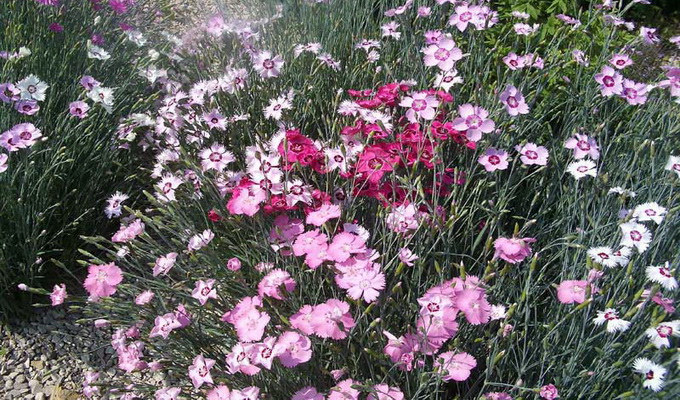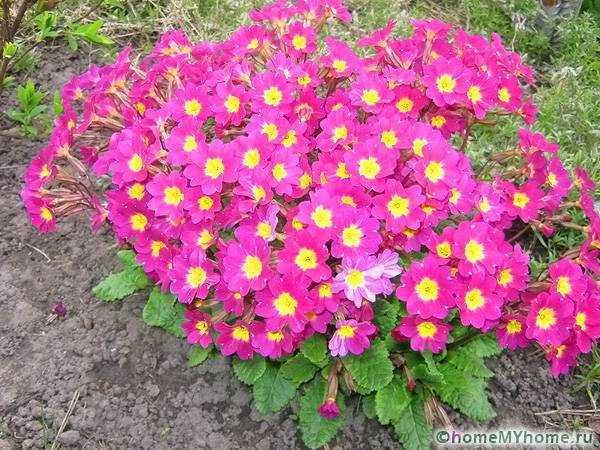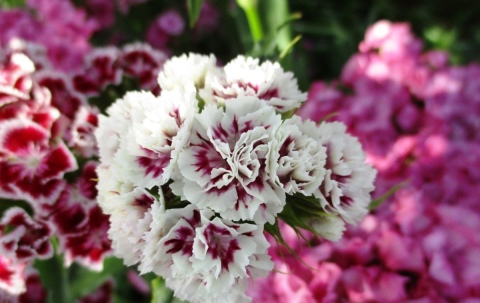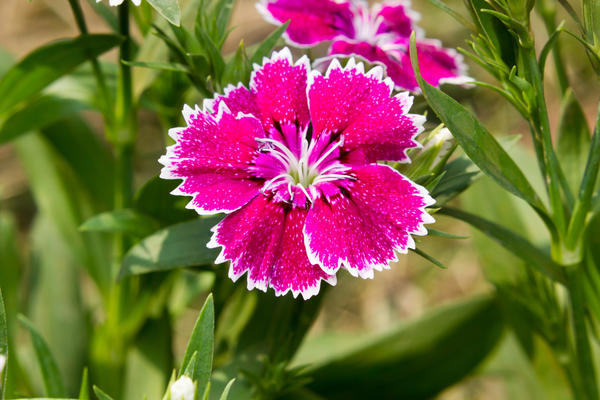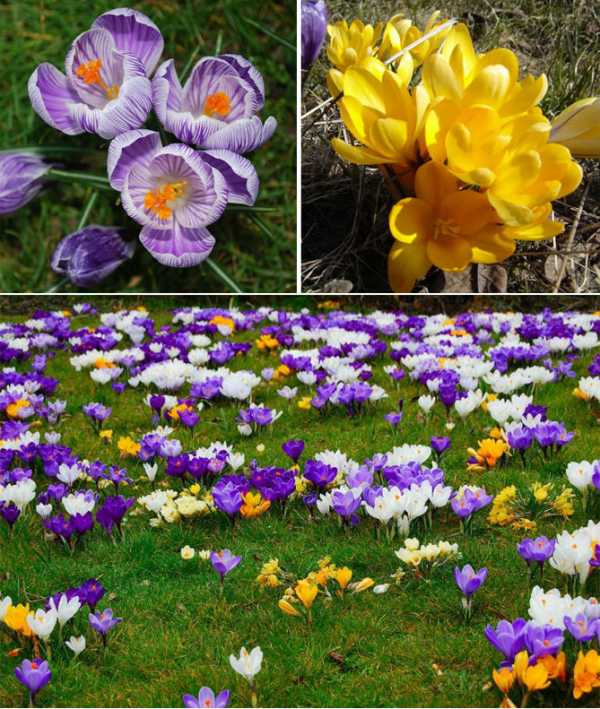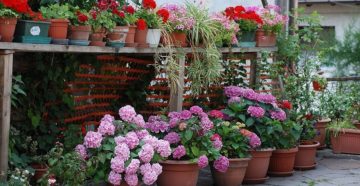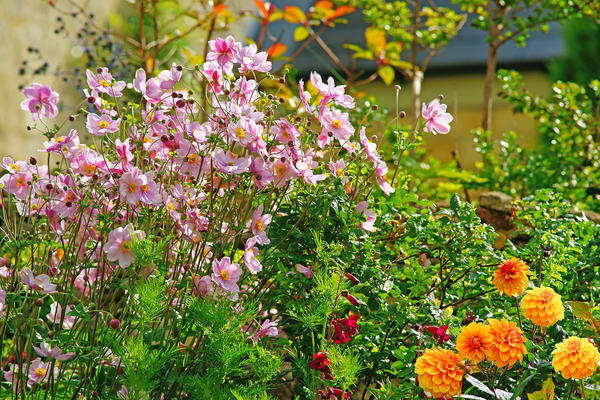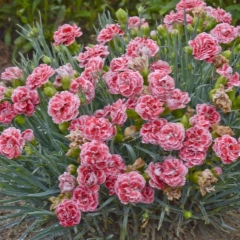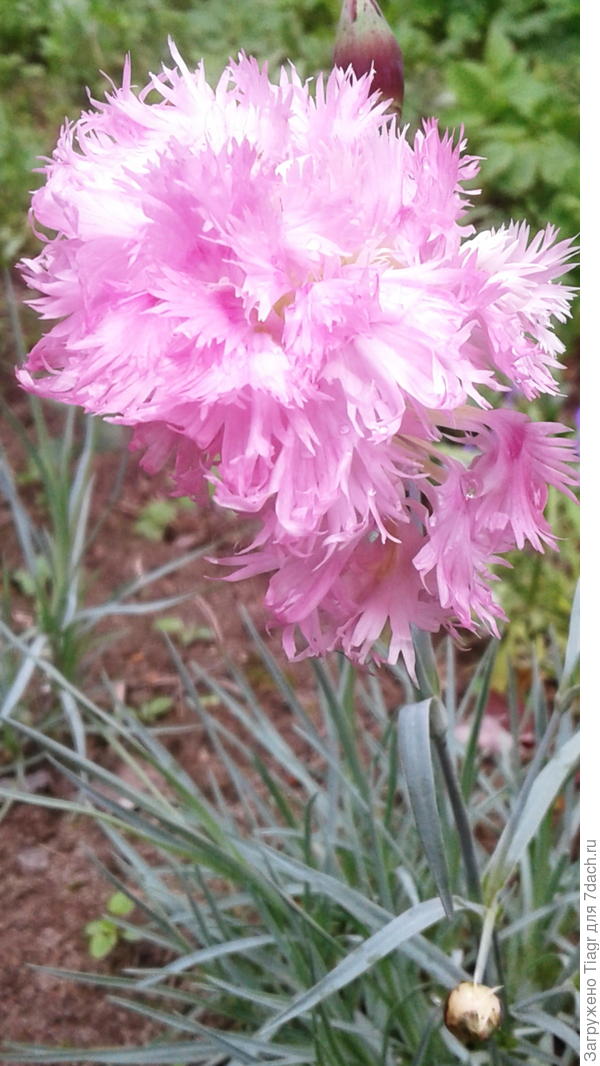Growing carnations outdoors
A perennial carnation, planting and caring for which will not cause difficulties even for novice flower growers - a plant that is unpretentious to the conditions. But some of the features of its cultivation must be known to every gardener.
Watering
The perennial garden carnation prefers frequent but moderate watering, approximately 0.5 liters of water is needed per plant. A plant can tolerate moderate drought, but an excess and stagnation of moisture is destructive for it.

Watering is carried out in the evening, trying to direct the flow of water directly under the root. It is necessary to loosen the soil after each watering, while removing weeds.
Fertilization
Garden and Turkish carnations, planting and caring for which, carried out correctly, bloom in the second year. In the first year of growth, nitrogen-containing fertilizers such as humus and urea can be used as top dressing to build up green mass.
Fertilizers that should not be used
It is forbidden to use manure and potassium chloride preparations as fertilizers for cloves
Top dressing must be done carefully so as not to oversaturate the soil with nitrogen.
From the second year of the growing season, garden carnations are fed according to the following scheme:
- Early spring - urea is introduced in a dry form and embedded in the ground;
- Budding - complex fertilizers for flowering plants "Kemira", "Master", "Universal", "Pocon", you can also use nitroammophoska and superphosphate (20 g per 10 liters of water);
- Flowering - complex mineral fertilizers.
Protection of cloves from diseases and pests
An unpretentious perennial carnation in care, the types and varieties with the photo of which we considered above, are vulnerable to pests and fungal diseases. Often the cause of plant damage is neglect of the rules of agricultural technology.

Such pests are dangerous for garden carnations: spider mites, aphids, bear, rootworm nematode. The fight against them can be carried out by spraying with insecticides: Aktara, Mospilan, Aktellik. You can also use proven folk recipes.
Infusion of potato tops
1 kg of chopped tops is insisted for 2 days in 10 liters of water, after which 2-3 tablespoons of liquid soap are added to the solution. Spray the carnation bushes with the mixture.
Onion husk infusion
Pour 20 g of husk into 1 liter of boiling water and leave for 4-5 days. The solution should be enough for planting 5-10 bushes, it is recommended to process it by spraying.
As a prophylaxis against diseases and pests, you should sprinkle the bushes with tobacco dust, and also plant calendula or marigolds near a carnation.
If the clove is affected by the rootworm nematode, then the bushes must be removed, and the soil must be repeatedly treated with boiling water and chemicals such as Mercaptophos or Phosphamide. It is necessary to place special traps from the bear.
Detailed information on the fight against the bear can be found in our material.
Turkish carnation planting and care of which is carried out without violations and following the recommendations is less likely to be affected by fungal diseases. But plants can get sick with fusarium, rust, rot due to temperature stress or changes in climatic conditions.
Disease prevention
An excess of moisture and nitrogen in the soil provoke the development of fungi. As a prophylaxis for ailments, plants are treated with fungicides: Fundazol, Topaz, Maxim, Chistotsvet - at the beginning and in the middle of the growing season. It is undesirable to plant carnations near tulips, as they are affected by the same diseases.
Comparison of wild and breeding varieties
Selective varieties of cloves appeared a long time ago.This undersized flower has been used in landscaping gardens and parks for centuries. Year after year, amateur gardeners have selected and bred plants with unusual color or petal shape, abundant flowering or large bushes.
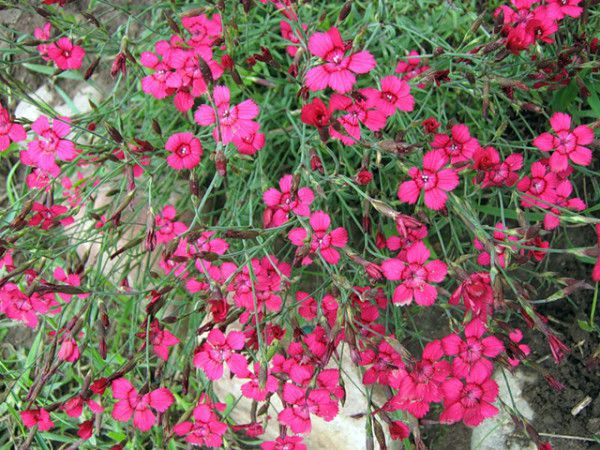
Carnation herb in the flowerbed
Currently, breeders have bred hundreds of decorative varieties of carnation herb... Breeding varieties are perennials just like wild ones. The cultivars have the following characteristics.
- Each bush produces many flowers.
- Plants have thicker foliage, some varieties have tall stems.
- Landings do not require shelter in winter, they are all frost-resistant.
- The breeding varieties are resistant to viruses and fungi.
- Cultivars are propagated by seeds, layering and root division.

Carnation herbal photo
Variety Diamond
This perennial plant has small (up to 1.5 cm in diameter) flowers of deep red and carmine red color. The central part of the flower has the same color.
The plant blooms profusely, inflorescences densely cover the dark green foliage. Leaves and stems have a whitish or bluish bloom. Seeds planted in the soil in late May or early summer sprout quickly. The diamond blooms from July to mid-autumn.

Variety Diamond
Toronto variety
Toronto's carnation flowers have an unusual appearance. The flower's five white, feathery petals expand at first and then taper slightly in the outer part, with a thin cherry-red edging at the outer edges. A dark red stripe runs across each petal, the central part of the flower, from the stripe to its center, is painted in a light cherry or pink color.
The foliage of the plant is dense and emerald green. This carnation also thrives on dense planting, blooms profusely and can create a continuous flower lawn. The flowering period begins at the end of June and lasts up to 40-48 days.

Toronto variety
Variegated lawn
Each bush of this variety is densely covered with dark red, burgundy, pink and white flowers. The flowering of plants is very abundant, which creates a high decorative effect.
The flowers have five feathery petals, which are slightly superimposed on each other, which gives the corolla volume. The lanceolate leaves and stems of the plant have a bright, rich green color. A lawn with cloves of this variety can bloom for up to 3 months.

Variety Variegated Lawn
Varieties
For planting in the garden, there is a large selection of types and varieties of carnations. Each of them differs in size, shape, color and flowering time.
Types of garden carnations
We list the most common garden species.
Dutch
One of the most popular garden species. Allocate high for cutting, medium and low varieties for flower beds. Grows well outdoors and in containers.
The most suitable for growing on the site are the Grenadines, Shabo, Margarita groups (recently appeared and little known).
When planted in May, the seedlings will bloom from July until the onset of cold weather. Then the carnation bushes can be transplanted into containers and transferred to the veranda or balcony, where the plant will continue to bloom. Common varieties: Pikoti Fantasy Mix, Champagne, Mont Blanc.
The height of an adult plant is up to 40 cm. Flowers are erect, up to 6 cm in diameter, densely double and with a pleasant aroma. Colors are yellow, white, red, lilac, burgundy, pink, different shades and combinations. To obtain large buds, the lateral peduncles are removed.
Plumose
A perennial plant that grows in a flower bed for 3 to 5 years. Over time, the bush grows in size and takes up all the free space around. Height is about 30 cm. It blooms from late May to September. Flowers can be single and in inflorescences, simple and double, bright pink or white. Small petals are dissected in the middle. The stems are thin and straight, the leaves are narrow. Loves the sun, abundant watering, stagnation of water in the soil is contraindicated. Prefers loose limestone soil.
Common varieties: Double Rose, Nana, Alba.
Curvy
Perennial, reaches 60 cm in height. Rhizomes are creeping, narrow straight leaves, flowers up to 4 cm in diameter, pink or lilac. The petals are cut into many fibers. Blossoms in mid-summer (June-July), possibly re-blooming in autumn (October). An unpretentious frost-resistant plant, it is a good honey plant.
Turkish
Most often found in flower beds in the garden. This plant forms a lush bush up to 50 cm. It blooms throughout the summer, forming a large number of buds collected in inflorescences. Differs in a characteristic spicy smell. The first two years bloom profusely, in the third - the buds appear rarely. A huge number of varieties and hybrids have been bred: "Albus", "Holborn Gloria", "Georgette" and others.
Carnation Knapp
Perennial native to Hungary and Romania. Shrub with few branches up to 45 cm high. Narrow green leaves, yellow flowers, serrated petals, up to 2 cm in diameter. Grown from seed, blooms in the second season. Frost-resistant, does not tolerate excess water in the soil, drought-resistant.
Stunted species
Another large group of carnations, distinguished by their miniature size.
Sandy
Perennial, belongs to carpet varieties, 15 to 20 cm high, small flowers up to 2 cm in diameter, with elongated teeth. Colors range from white to pink. Blooms from June to August. An unpretentious and luxuriantly flowering plant.
Herb or deltoid
Forms a dense carpet covering the soil. Grows up to 25 cm, dark green stems and leaves often with a reddish tint. An unpretentious perennial plant that grows in one place without transplanting from 4 to 7 years. Blooms from early summer to August. The flowers are small, jagged along the edge of a wide variety of shades and combinations from white to pink and red.
Differs in abundant flowering. After ripening, the seeds self-sowing fall into the soil, have a high degree of germination.
Alpine
The bright green bush grows up to 25 cm high. Thin straight stems are covered with narrow leaves. Flowers about 5 cm, with small denticles at the edges, pink, bright scarlet, red, purple. Unpretentious, grows on poor soils, suitable for northern regions with harsh climatic conditions.
The most famous types and varieties of cloves
Turkish carnation

Turkish carnation
This type of carnation is most commonly used for horticulture. The biennial forms a lush bush up to half a meter high. Carnation flowers cover the entire surface of the bush in an even and dense layer, forming a colored cloud. This is one of the most popular types of this plant. The homeland of the Turkish carnation is considered to be Southern Europe, where the flower has taken root in the wild.
Despite the fact that the Turkish carnation is a perennial, gardeners prefer to renew the plant every two years due to a sharp decrease in flowering. In the first year, the plant forms a lush bush, and in the second it begins to bloom profusely for several months. In the third year, the Turkish carnation practically loses all its decorative qualities.

Turkish carnation
The most popular varieties of Turkish cloves include the following: Red Monarch, Kupferroth, Vice Risen, Mirage.

Turkish carnation (bearded)
Dutch carnation
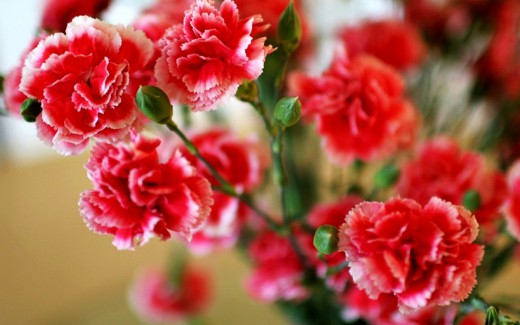
Dutch carnation
This type of flower is known to everyone, because it is he who is grown in greenhouses and sold in flower shops. The stems of the flowers are long - more than a meter, knotty, the leaves are small, narrow, dark green. The Dutch carnation is divided into three subspecies of varieties: tall (for sale), medium-sized and low-growing (for landscaping flower beds). It is from the Dutch carnation that Shabo and the Grenadines originated, which are considered to be separate types of flowers.

Garden carnation (Dutch)

Dutch carnation in the garden
Carnation Shabo

Carnation Shabo
This type of carnation can be both an annual and a biennial, it all depends on the growing area.In the southern regions, this plant most often grows for two years, in regions with a temperate climate - one. This is a rather thermophilic species, but tolerates small frosts easily. The plant does not form a lush basket, the stems of this type of carnation are rather fragile, with a large number of nodes. The leaves are small, dark green. The flowers are terry, with a large number of petals, the diameter is up to 7 cm. The color of the flowers is very diverse, it all depends on the variety. Shabo carnations are very fragrant, have a long flowering period, and when cut, keep freshness in water for a long time.

Shabo carnation in the garden
The most popular varieties of this species: Zhanna Dionysus, Aurora, Luminette Mix.
Carnation Grenadine

Carnation Grenadine
This type of two-year-old carnation is distinguished by its unpretentiousness and frost resistance, which makes it possible to grow flowers even in regions with a temperate climate. The plant is medium-sized - the height of the stem is no more than 45 cm. Carnations form a rather lush bush with a large number of knotty stems. A well-developed basket contains more than 180 stems with flowers. The flowers of this type of carnation are very large, strongly fluffy, with a wide range of colors. In the first year, a large basket is formed, the second year is distinguished by long and abundant flowering. The frost resistance of the carnation species allows it to winter in the ground without any consequences for the plant.
Chinese carnation

Chinese carnation
This type of annual plant is distinguished by its unpretentiousness, good germination and high flowering capacity. The height of the bush does not exceed 40 cm, the stems are knotty, with a large number of narrow leaves. The flowers are weakly double, 6-7 cm in diameter. The flower petals are paired, with denticles along the edge. The color of flowers is very variable, some varieties are multi-colored. A distinctive feature of the species is burgundy stripes along the petals.
When and how it blooms
Muraya - caring for the tree of Japanese emperors at home
There are over 3 hundred types of carnations. Some are cultivated indoors. Among them there are decorative and hybrid species. Household crops are annual or perennial.
Attention! To create a beautiful flower bed on the windowsill, seeds of different varieties are placed in one container
Flowering period
The usual time to start flowering is 3-4 months after planting in a pot. Flowering continues from early spring to the very frost, depending on the type of carnation. Flowers do not fade for a long time and retain their aroma and freshness for about 5 weeks. If a carnation is planted in the fall, then it blooms in six months. To extend the flowering period, dried flowers are removed.
Terry Chinese carnation
Types of flowers
Select compact types of home carnation flowers, for example:
- The Chinese species is a one-year-old with creeping stems, the height of which is 25–30 cm. The flowering period is June - October. The flowers are white, red, pink or lilac in color, with patterned petals and jagged edges.
- Turkish or bearded carnation is a two-year culture. Branching stems, 20-25 cm high. Flowers 1 cm in diameter. Double or simple. The inflorescences are 12 cm in diameter. Blooms in the second year from planting. In the third year, the carnation is disposed of.
- Dutch or Garden variety. Only the Grenadine variety is grown indoors. The culture is perennial, grows up to 40 cm, blooms in the second year of life from February to late autumn. The flowers are simple or double, pink, white, variegated, yellow and red.
- Hybrid short, up to 20 cm. The flowers are graceful with dissected petals and a wonderful aroma.
- Indian - evergreen low bush with shiny leaves, white flowers and inflorescences of 10 buds. The buds have 5 petals and a pleasant scent.
Turkish indoor carnation
In addition to these species, the Shabo carnation blooms until late autumn. Growing Shabo cloves from seeds at home is impossible.This is a garden version and gets into the room only with the onset of cold weather, when Shabo is dug from the site, planted in a pot, then transferred to the house, where it blooms until mid-November.
Carnation Shabo
Short description
Many were treated with her for illnesses and admired everything at different times. Carnation is a beautiful and cold-resistant flower that can be planted:
- in the open field in the country or in the front garden;
- at home in a pot.
The variety of species of this "divine flower" allows us to admire its various sizes from 5 cm to 100 cm and many bright colors. This flower also has a special scent.

The most common type of carnation used for planting in Russia is "Turkish carnation" or its second name is "bearded". She is unpretentious, she does not need a lot of light and there is no need to shelter her for the winter.
Various types of carnations bloom from June to late autumn, given this fact, you can make them bloom all round the summer. For example, in warm regions, in May the glacial and feathery variety already bloom, in June the chalk and Turkish bloom, June-July is the time of the stone and Amur, and the Chinese can bloom until autumn.
Diseases and pests
The Turkish carnation is a sturdy plant that is resistant to most of the known diseases. Strong immunity makes this plant even more popular. In rare cases, this culture can suffer from serious diseases such as:
- fusarium - the main symptoms here are the twisting of the leaf blades, and then the drying of the flower;
- rust is a very serious disease that manifests itself in the formation of well-visible orange spores;
- gray mold is an equally dangerous ailment that can manifest itself if the flower is grown in excessively moist areas;
- mottling is a viral disease, usually activated in the spring and manifests itself as the appearance of spots of incomprehensible shapes on the foliage.
Fusarium can be treated with a solution of copper oxychloride or 0.1% suspension of foundationol. But before that, you need to get rid of all areas of the plant affected by the disease. Gray rot is treated with the same means, but before that, all the rotten areas of the flower are removed. If the carnation has suffered from rust, then all infected bushes must be destroyed as soon as possible.
Turkish carnation can suffer from pest attacks. Often it is attacked by aphids, which can greatly deplete the plant and make it very susceptible to dangerous fungal infections. You can get rid of aphids if you turn to the treatment of the plant with insecticidal agents, such as "Arrivo", "Intavir" or "Fitoverm". These formulations are used several times, taking breaks of 5-7 days.
The plant can also be affected by spider mites. If this pest attacked a flower, characteristic whitish grains will appear on the lower half of the leaf plates. You can see a flying white spider web. Feverfew or sulfur preparations can be effective means in the fight against spider mites.
Bears also often attack Turkish carnations. They can severely damage flowers, young shoots and plant roots. You can get rid of them only by digging up the soil in the autumn season. Thus, a kind of trap pits filled with manure are formed. The larvae will move there for wintering and can be easily destroyed in spring.
Dangerous for flowers and earwigs. They also damage flowers, seedlings and young shoots. For these pests, traps are made from wet grass, covered with small boards. The parasites will hide there during the day in search of escape from the summer heat.

